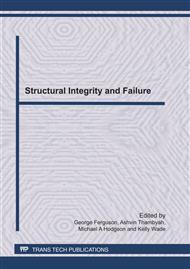[1]
Back, W., Intralimb coordination: the forelimb and hindlimb, in Equine locomotion, W. Back and H.M. Clayton, Editors. 2001, WB Saunders Co: London. pp.95-133.
Google Scholar
[2]
Brama, P.A.J., et al., Contact areas and pressure distribution on the proximal articular surface of the proximal phalanx under sagittal plane loading. Equine Veterinary Journal, 2001. 33(1): pp.26-32.
DOI: 10.2746/042516401776767377
Google Scholar
[3]
Biewener, A.A., et al., Bones stress in the horse forelimb during locomotion at different gaits: A comparison of two experimental methods. Journal of Biomechanics, 1983. 16(8): pp.565-576.
DOI: 10.1016/0021-9290(83)90107-0
Google Scholar
[4]
Thomason, J., The relationship of structure to mechanical function in the third metacarpal bone of the horse, Equus caballus. Canadian Journal of Zoology, 1985. 63: pp.1420-1428.
DOI: 10.1139/z85-212
Google Scholar
[5]
Brown, N.A.T., et al., Force- and moment-generating capacities of muscles in the distal forelimb of the horse. Journal of Anatomy, 2003. 203(1): pp.101-113.
DOI: 10.1046/j.1469-7580.2003.00206.x
Google Scholar
[6]
Lewis, C.W., et al., Evaluation of subchondral bone mineral density associated with articular cartilage structure and integrity in healthy equine joints with different functional demands. American Journal of Veterinary Research, 2005. 66(10): pp.1823-1829.
DOI: 10.2460/ajvr.2005.66.1823
Google Scholar
[7]
Riggs, C.M., G.H. Whitehouse, and A. Boyde, Pathology of the distal condyles of the third metacarpal and third metatarsal bones of the horse. Equine Veterinary Journal, 1999. 31(2): pp.140-148.
DOI: 10.1111/j.2042-3306.1999.tb03807.x
Google Scholar
[8]
Meachim, G., Light microscopy of Indian ink preparations of fibrillated cartilage. Annals of the Rheumatic Diseases, 1972. 31(6): pp.457-464.
DOI: 10.1136/ard.31.6.457
Google Scholar
[9]
Hayes, W.C., et al., A mathematical analysis for indentation tests of articular cartilage. Journal of Biomechanics, 1972. 5(5): pp.541-551.
DOI: 10.1016/0021-9290(72)90010-3
Google Scholar
[10]
Thambyah, A., A. Nather, and J. Goh, Mechanical properties of articular cartilage covered by the meniscus. Osteoarthritis and Cartilage, 2006. 14(6): pp.580-588.
DOI: 10.1016/j.joca.2006.01.015
Google Scholar
[11]
Jurvelin, J., I. Kiviranta, and J. Arokoski, Indentation study of the biomechanical properties of articular cartilage in the canine knee. Engineering in Medicine, 1987. 16(1): pp.15-22.
DOI: 10.1243/emed_jour_1987_016_006_02
Google Scholar
[12]
Räsänen, T. and K. Messner, Regional variations of indentation stiffness and thickness of normal rabbit knee articular cartilage. Journal of Biomedical Materials Research, 1996. 31(4): pp.519-524.
DOI: 10.1002/(sici)1097-4636(199608)31:4<519::aid-jbm12>3.0.co;2-b
Google Scholar
[13]
Zhang, M., Y.P. Zheng, and A.F.T. Mak, Estimating the effective Young's modulus of soft tissues from indentation tests - Nonlinear finite element analysis of effects of friction and large deformation. Medical Engineering and Physics, 1997. 19(6): pp.512-517.
DOI: 10.1016/s1350-4533(97)00017-9
Google Scholar
[14]
Verteramo, A. and B.B. Seedhom, Zonal and directional variations in tensile properties of bovine articular cartilage with special reference to strain rate variation. Biorheology, 2004. 41(3-4): pp.203-213.
Google Scholar
[15]
Korhonen, R.K., et al., Importance of the superficial tissue layer for the indentation stiffness of articular cartilage. Medical Engineering and Physics, 2002. 24(2): pp.99-108.
DOI: 10.1016/s1350-4533(01)00123-0
Google Scholar


